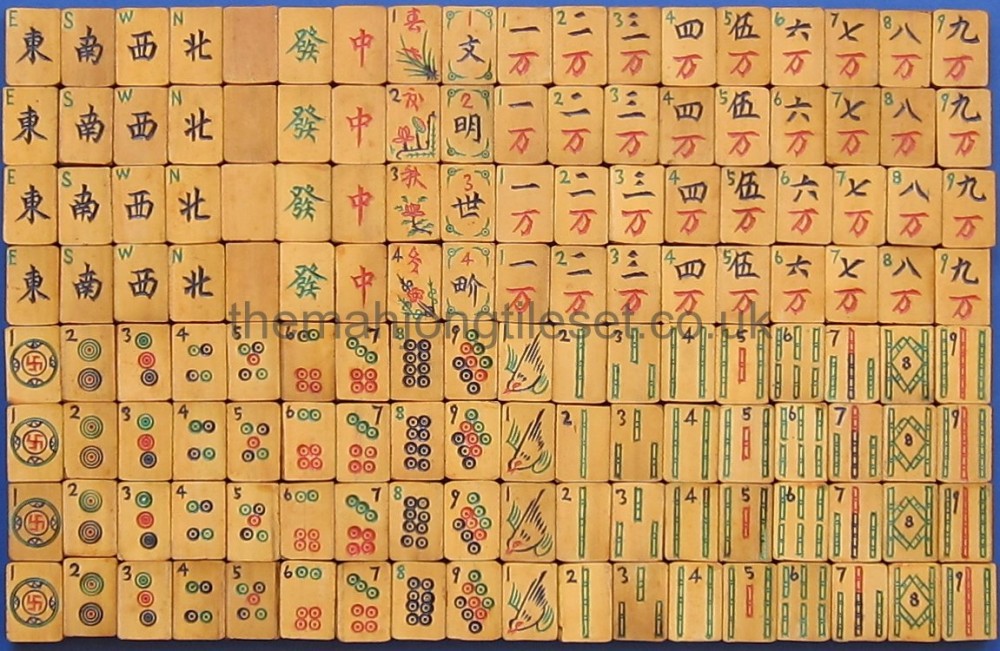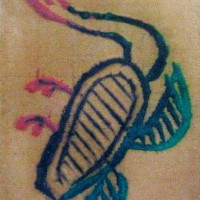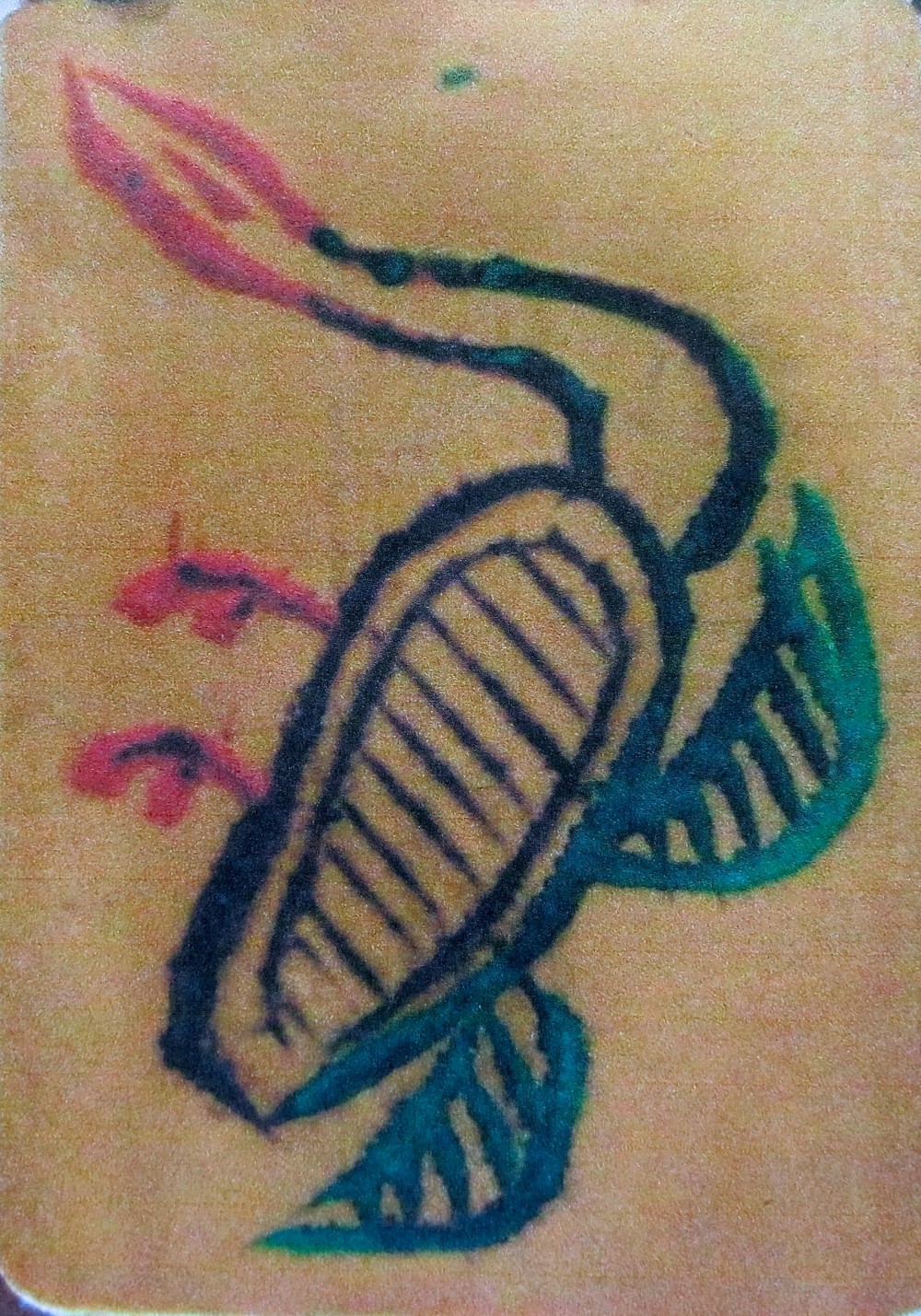
This Gallery features tile sets made of bamboo that feature a Relict engraving style such as in the Winds/Directions group and in the Cash/’Circles’ suit and in four of the (framed) ‘Season’s’. The presence of a tile group (the Flowers) from a later tile set composition plus the presence of a suit with an earlier engraving style suggests these sets are the result of Hybridisation (please read the Introduction to Gallery 1.1).


Another set showing rare, early, features. This set also shows a 'hybrisation' feature between different tile patterns. In this case it sports the Glover and Laufer engraving style on the West and North tiles. Further, the 'Circles' have tiles with the early feature of single circles on them and with the number one 'Circle' incorporating a Swastika. The Swastika is found on the Mauger set of 1915. It is one of the oldest symbols in China (and India). Its meaning is 'infinity' and may represent here great wealth due to its association with the Cash/'Circles' suit. The diamond shape to the nine 'Circles' tile is a common feature found in 1920's sets. Another early feature are the framed 'Seasons' bearing one red sinogram each. From the top; wen, ming, shi, jie, that is, "Civilized World".


Fold open, thin leather-covered thick cardboard box, sealed via a string and a Chinese coin.


This bamboo set is a striking example of hybridisation. 1stly, note the Relict Feature of the West sinogram in the Directions, with its nearly parallel vertical lines joining the top horizontal line. This is in keeping with other identical 'West' sinograms in this section and is in keeping with that sinogram found in the Glover sets.
2ndly, we have the Circles suit with tiles 4-9 which have single circle with a dot in the middle. This is another Relict Feature 1st encountered in the Glover sets of 1875.
Thirdly, we have the 'Flowers' and 'Seasons' tiles. The Flowers are in a frame device and this is another feature of these hybridised sets. The Flowers are Si Junzi, 四君子, the Four Junzi, or the Four Gentlemen. 'Gentlemen' here probably reflects the Confucian ideal of Junzi not as a commander of, or ruler over, inferior subjects but rather a moral person who leads by his character and conduct. Thus the definitions of each of the "flowers" reflect on the moralistic behaviour of the Junzi. For example;
(Tile #1) 梅, Mei, Plum a Winter flowering shrub, symbolises courage and hope, standing firm in conviction because it blossoms first and bravely stands against the dangers of Winter. The plum blossom is also symbolic of endurance as it often flowers when the snow is still on the ground. The flowers, which may be pink or white, appear before the leaves and this is how they are depicted in paintings. There's a Chinese saying "...bitter cold adds keen fragrance to plum blossoms..."
(Tile #2) 蘭, Lan, Orchid, an indicator of the Spring and stands for humility, modesty, beauty and refinement. It is the delicate wild orchids that are referred to as they tend to grow in inaccessible areas such as crevices in rocks overlooking rivers or streams, and you could easily walk past without noticing them.
(Tile #3) 竹, Zhu, Bamboo, a Summer flower. Perceived as upright, strong and resilient while still being gentle, graceful and refined. The bamboo is symbolic of both physical and mental strength as it will bend and sway in the severest of gales but does not break.
(Tile #4) 菊, Ju, Chrysanthemum, blooms late in Autumn and in facing the coming Winter symbolizes people who maintain their virtue despite adversity and temptation. The chrysanthemum is thought of as a loner, as it prefers the Autumn, which is less crowded with flowers than the profusion in Spring.[My special thanks to Ray Heaton for his exemplary work with translation of these terms.]
The Seasons also show the Relist feature of a centrally placed large red sinogram - also found in the 1875 Glover sets.
The 1 tile Season is Spring, 春 Chun, displays the Cymbidium (type of Orchid, 蘭, lan), the flower of Spring.
Tile 2 is Summer, 夏 Xia, displaying the Lotus, 蓮, lian, the flower of Summer.
Tile 3 is Autumn, 秋, qiu, displaying the Chrysanthemum, 菊, Ju, the Flower of Autumn.
Tile 4 is Winter, 冬, Dong, displaying the Plum Blossom, 梅, Mei, the flower of Winter.


When placed in this orientation, the number 1 Bamboo bird tile shows some interesting features. 1stly there are the parallel lines of the body and 2ndly the curved neck and 3rdly the red head.
These features are similar to what is found in the engraving of a String of Cash/Mayfly tile of the Wilkinson 1889 and Laufer 1901 sets plus other featured in the Bne/bamboo section of Gallery 1.1.
It may be that these features are a coincidence but the parallel lines in particular are a feature not seen in other birds of this type.